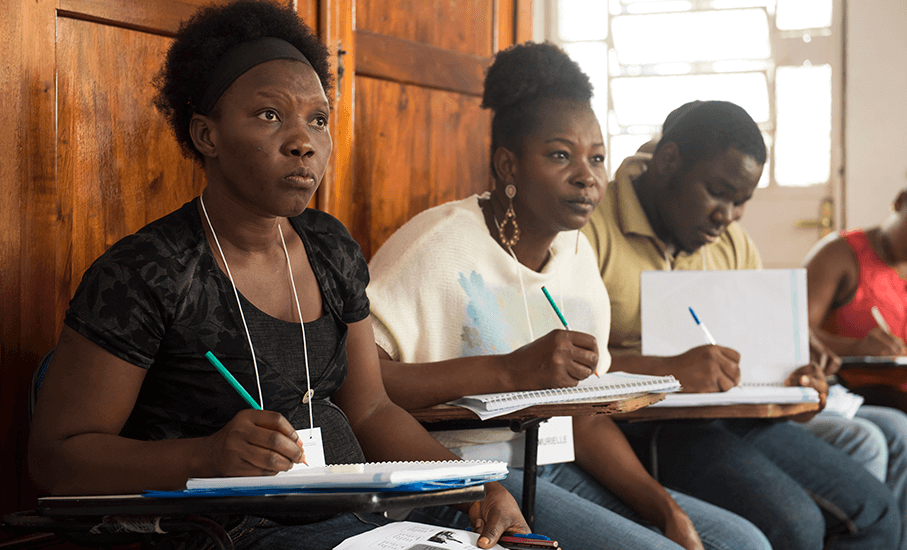PUCRS-PrInt project analyzes the impact of yesterday’s and today’s migrations
Project looks at historical issues, transculturalism and traumas

Photo: Camila Cunha
Migrations: historical and conceptual perspectives and analysis of contemporary phenomena is one of the PUCRS-PrInt projects that has been awarded funding through the Institutional Program of Internationalization (PrInt), by Capes, the Brazilian Federal Agency for Evaluation and Support of Graduate-level Education. This project congregates History, Philosophy, Education, Theology and Psychology researchers in an effort to address historical issues associated with human mobility. It also seeks to address transcultural as well as identity and health aspects resulting from migration or refuge and which have commonly been observed over the course of history. In four years, the project intends to reach out to dedicated scholars from Europe and USA.
Dr Antonio de Ruggiero, a School of Humanities professor and one of the coordinators of the project, claims that back in the 19th century, the world was already global. He goes on to say: “Migrations are privileged phenomena in that we can see changes in contemporary societies, including the consolidation of social networks and the recognition of citizenship rights, as well as the integration of youth into a new form of entrepreneurship”.
Cultural hybridism
Past migrations produced cultural hybridism processes in several areas, such as religion, cuisine, art, music, political thinking, language, literature and journalism. In De Ruggiero’s view, the earliest bourgeois travelers in the 19th century relished the multiracial composition of Rio Grande do Sul and the amicable relationship between the different peoples. He claims that, unlike today, in the past, a colonization policy was in effect. “In 1824, the state had a population of 100,000 inhabitants. Back then, Germans and Italians were deeply dissatisfied, although there was a project to welcome them. The first agrarian reform saw the creation of a middle and small proprietary classes.”
Immigrants held their ties with their home countries. The state would even open its doors to some priests from Italy. In an effort to preserve their identities, they created newspapers to defend their country more than those who were living there. Researchers find it hard to find these materials in Brazil. There are not many issues of La Patria Italo-Brasiliana at the Hipólito José da Costa Museum. Some yearly issues of that newspaper can be found at the Benno Mentz archives, at Delfos – Center for Documentation and Cultural Memory of PUCRS. De Ruggiero claims that it is much easier to find these collections in Italy. I got a very good Stella d’Italia collection. However, due to the fact that cultural preservation is an issue in Brazil, and to the troublesome political moment, some parts of it are missing. “In 1942, when president Getúlio Vargas allied with the USA, the use of Italian was banned and these newspapers were discontinued.”
The earliest forms of instruction of migrants’ kids, the teaching practices as well as the models used to reinforce their ethnic identity (curriculum, course books and public memories) are the areas that are going to be studied.
Laws and regulations
“How should immigrant groups address the need to integrate into the communities they have migrated to without losing their identity? What are the limits of this integration, if any? How do the different forms of integration lead to minority or differentiated groups and consequently pave the way for segregation?” These issues are being addressed by School of Humanities Professor, Dr Roberto Hofmeister Pich, who is responsible for the research into the legal and regulatory aspects of the project Migrations.
In view of the current reality of Brazil, and claims that we need to “assume or at least make concessions about historical responsibilities in view of so much injustice that has been done” when we talk about this problem. He mentions the “violent processes of ‘internal’ migration, as aboriginal groups lose their space to mainstream groups, and ‘external’ migration, as he relates to the outrageous and long-lasting slavery and trafficking of African peoples”.
In the first half of the 16th century, this became an area of interest for Philosophy scholars, due to the overseas “discoveries”. “The 16th century Iberian schools of thought – both Catholic and scholastic in their philosophical, legal and theological culture –, initiated a new paradigm and people started looking at the forms of migration under a ‘normative’ perspective. People became morally concerned for a variety of reasons, including the right to emigrate / immigrate and the duty to receive or provide a warm welcome to strangers, in view of their distinct interests and needs”, Pich says.
In 1539, Dominican Spanish Francisco de Vitoria (1483-1546), in his first effort to touch upon the recently discovered Indians, addresses the right to immigrate based on the general natural principles of society and communication between humans. The new pre-modern and modern phenomena propelled the School of Salamanca, in the 16th and 17th centuries, to reflect upon colonization as a form of economic exploitation and creation of stable population centers, at the international level, and labor, in the perspective of the global mercantilist economy.
The philosophical approach started to critically assess the relationship between human processes of migration and natural and civil rights of individuals and groups. “At that time, we could see that the natural principles of communication and society underlie the right to immigrate. Also, the latter has been conceived in view of the idea of belongingness and having a home.”
Xenophobia and racism affect mental health

Italian family in Ana Rech, in 1904. Photo: Historical Archive João Spadari Adami
Unlike in previous successful immigrant waves that enriched the culture of Rio Grande do Sul and Brazil, as a whole, in that several peoples blended in amicably, today’s reality is quite different as new arrivals struggle to fit in. In interviews that were conducted with Haitian immigrants at the Center for Research in Trauma and Stress (Nepte), they claimed that xenophobic and racist attitudes they have experienced have a direct impact on depression, anxiety and post-traumatic stress disorder (Ptsd) a lot more than the earthquake they experienced in Haiti in 2010 and the adverse socioeconomic conditions. “Discrimination becomes clearer as they become more fluent in the language and understand the context they live in”, Dr Christian Kristensen says.
Immigrants also have problems dealing with the Brazilian culture and with the possibility of not being able to return to Haiti in case of an emergency. “The welcoming conditions have an important impact on the mental health”, says Alice Brunnet, who defended her Master’s thesis in the Graduate Program in Psychology. Brunnet was advised by Kristensen, who coordinates the research project and the center. “The most important reason they come to Brazil is to find a job to provide a better life for their families”, she says.
The School of Health Sciences provides counselling sessions to the community, at no charge, at Nepte. Kristensen claims that one of the challenges for PUCRS is to have a reference center for immigrants. The service is being offered through a specific program developed by the Pastoral and Solidarity Center. It also includes legal counseling sessions and a Portuguese language program. Not many people look for the services offered at the center and this is the reality in other countries, too.
When she was working on her major in Psychology, Laura Bolaséll tried to communicate with Haitians in Creole. “Although I did not know much about the language, starting the service using Creole would break the ice and establish a connection. They felt at home and embraced because someone was there for them.” Laura served as a research assistant and BPA/PUCRS and Fapergs grantee from 2015 to 2018. Today, she is working on her Master’s in Psychology at PUCRS. In Kristensen’s view, trauma-focused cognitive-behavioral therapy can produce very good results with these individuals. “We try to get them to spill out all the traumatic events they have experienced over the course of their lives. They have these memories in themselves.”
Comparing Brazil and France
The scope of the study is expanding, as 70 individuals from Brazil and 70 from France will be involved in the investigation. It is not so simple for the colonized peoples to blend in in the European society. “Overall, Haitians, are relegated to the outskirts of Paris”, Kristensen says.
This is what Alice is going to study in her doctoral research internship at the Université de Bourgogne – Franche-Comté (France), as a CNPq grantee. In her view, in Brazil, it is fine to get a work permit. However, it is hard to get a job and earn a good pay. “In France, there are many bureaucratic setbacks immigrants have to face. As a consequence, there is a shortage of jobs and housing. Immigrants also have problems with the police. However, once they get regular status, it is a lot easier for them to get jobs and other state benefits”, she says.
* The article was published in the Revista PUCRS Nº 189.






